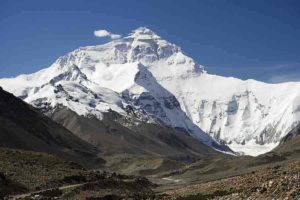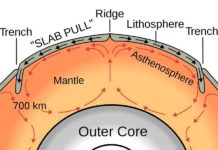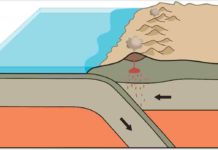
Minerals trapped inside tiny crystals that have survived the grinding of the continents over billions of years may help to reveal the origins of plate tectonics and perhaps even provide clues about how complex life sprang up on Earth.
The theory of plate tectonics—which describes how the Earth’s crust is separated into plates that float and slide on a layer of malleable rock below—became widely accepted by science around 50 years ago. The process is believed to have largely shaped the world around us by enabling continents to form, throwing up enormous mountain ranges when they collide, creating volcanic islands and triggering catastrophic earthquakes.
But there is still debate about exactly how and when in our planet’s 4.5-billion-year history the plates formed, estimates vary from less than one billion to 4.3 billion years ago.
It is also unclear exactly how quickly plate tectonics evolved, says Dr. Hugo Moreira, a geologist at the University of Montpellier in France. Did Earth’s crust split abruptly into multiple plates and start moving over just tens of millions of years, or was the process far more gradual, taking hundreds of millions of years or more?
Understanding this could prove crucial for understanding not just how the planet itself has evolved, but also how life may have been kickstarted on Earth. The conditions created by plate tectonics are thought to have helped make Earth hospitable to life in the first place and also provided vital nutrients needed for complex multicellular life to prosper.
Crystal time capsules
Dr. Moreira and his colleagues are seeking answers to these questions inside tiny zircon crystals, which are time capsules of Earth’s distant past due to their extreme robustness. They are often found preserved in rock despite the action of continual weathering and geological events.
Many of these crystals have previously been dated by analysing the radioactive decay of isotopes—different forms of elements—that they contain. Some have been found to date as far back as 4.4 billion years ago, the earliest known fragments of Earth’s crust.
“That’s why zircon’s amazing, because although the rocks that compose the continents were destroyed, the zircon survived in the sedimentary record,” said Dr. Moreira. Scientists have previously used zircon crystals to study the history of the Earth’s continental crust, but it has not yet been enough to provide a definitive consensus for how plate tectonics started, he says.
“After analysing hundreds of thousands of them, we still do not have an agreement,” said Dr. Moreira, a member of the MILESTONE project being led by Dr. Bruno Dhuime, a geosciences researcher for the French National Centre for Scientific Research also at the University of Montpellier.
The researchers are hoping to use these crystals—which typically measure about a tenth of a millimetre, or roughly the thickness of a human hair—to improve our insight into the timing and evolution of plate tectonics.
The MILESTONE group will drill down to an even tinier scale—about a hundredth of a millimetre—to examine traces of apatite and feldspar minerals trapped inside the zircon crystals. Strontium and lead isotopes in these ‘inclusions’ can add unprecedented detail on the zircon’s source of formation and whether this occurred in the varying types of magma below stagnant or moving plates, says Dr. Moreira.
“It will be a critical step towards a better understanding of how our planet evolved,” he said. “If we manage to measure the isotopic composition of these tiny inclusions, we might tell what was the composition of the rock from which the zircon crystallised. We can perhaps understand how evolved the crust was at that point and in which type of tectonic settings the magma was formed.”
This tiny-scale analysis been made possible by the set-up of a laboratory containing a specialised, highly sensitive mass spectrometer, equipment that measures the characteristics of atoms.
The team hopes to start analysing samples next month, ultimately investigating inclusions in more than 5,000 zircons of varying age from all over the world to build up a wide-scale picture. “What we want to do is pinpoint when plate tectonics went global instead of when it was localised in isolated points here and there,” said Dr. Moreira.
Underground structures
At the opposite end of the scale, other researchers have been seeking clues to the origins of plate tectonics in two massive continent-sized structures found deep underground beneath the Pacific and African plates.
These ‘thermochemical piles,” mysterious structures located about 2,900 kilometres below the surface at the boundary between Earth’s core and mantle, were discovered in the 1990s with the aid of seismic tomography—imaging from seismic waves produced by earthquakes or explosions. They were detected as potentially warmer areas of material in which seismic waves travel at different speeds than in the surrounding mantle, but there is still much debate about exactly what they are, including their composition, longevity, shape and origins.
Over the past couple of decades, a ‘fiery’ debate has arisen over their proposed link to movements on the planet’s surface and so their potential involvement in the emergence of plate tectonics, explained Dr. Philip Heron, a geoscientist who studied the structures as lead researcher on the TEROPPLATE project at Durham University.
“These piles are thought to have an impact on how material moves within the planet, and therefore how the surface behaves over time,” he said. Events on the surface may in turn drive their activity.
One theory is that these piles are stable for long geological periods and their edges correspond with the position of key features involved in plate tectonics on Earth’s surface, such as supervolcanoes.
However, their extreme depth makes these piles difficult to observe directly. “Given that these structures are in places 100 times higher than Mount Everest, they may be the largest things in our planet that we know the least about,” said Dr. Heron.
Supercomputer power
The TEROPPLATE project harnessed supercomputer power to investigate. Using more than 1,000 computers working in tandem, the team developed 3-D models of Earth to show how the assumed chemical composition of large hot regions deep underground might influence the formation and location of deep mantle plumes.
However, their models indicated that the piles may be more passive in plate tectonics than initially thought and that the world would still form similar geological features without them. “When looking at the positioning of large plumes of material that form supervolcanoes, our numerical simulations indicated that the chemical piles were not the controlling factor in this,” said Dr. Heron.
But he added that these findings were not fully conclusive and have also opened the door to other interesting avenues for research—such as exploring the implications that these structures are constantly moving through the mantle rather than being largely stationary.
“It gives weight to the theory that the chemical piles may not be rigid and fixed in our planet, and that the deep Earth may evolve as readily as the continents on our surface move around,” he said. “It’s a push to start looking deeper.”
Some of TEROPPLATE’s results also indicate that the piles may have been robust enough to survive Earth’s earliest beginnings. That makes it feasible for them to have been around for the start of plate tectonics and thus to have had roles in the process that we don’t yet know about, adds Dr. Heron.
All of this could have implications for understanding our own place on Earth too. If, for instance, plate tectonics evolved rapidly early in Earth’s history, it may raise questions such as why complex life didn’t emerge earlier or just how closely the two are linked, says Dr. Moreira.
“To fundamentally understand where plate tectonics comes from is potentially the essence of life,” added Dr. Heron. “On Earth, there’s not a thing that hasn’t been impacted by it.”
Note: The above post is reprinted from materials provided by Horizon: The EU Research & Innovation Magazine. The original article was written by Gareth Willmer.










